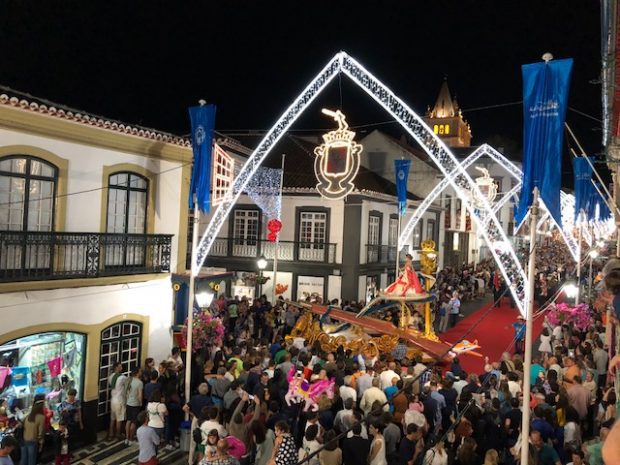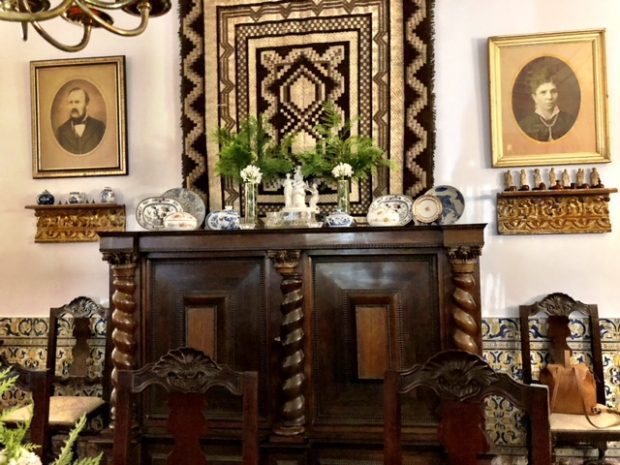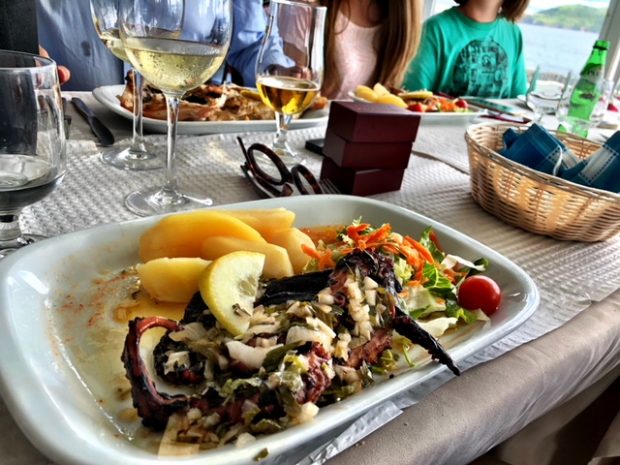Azores Postcard: The Final

It occurs to me that I never did write a wrap-up of my Azores trip. Let me fix that, because there are good things to talk about … and we could use some good things to talk about around here.
When last we spoke of the Azores, I was upchucking on an ocean ferry to the island of Terceira while a folk group was singing “Feliz Navidad” nearby. Happily, the next two days on Terceira were the highlight of the trip. The island is so small that I kept running into the Azorean-Americans who sat near me on the ferry ride. We’d say, “Feliz Navidad” to each other, and burst into laughter.
Our party — which, I don’t mind saying now, was my family, as well as our friend Ryan and his daughter Grace — checked into our hotel in the beach town of Praia at the far eastern end of the island. After we rented cars, we motored into Angra do Heroismo, the main town on the island. Angra, which was founded in the 15th century, is a UN World Heritage site. We parked and made our way down to the harbor. There we saw a statue of Vasco da Gama, the Portuguese explorer, who stopped in Angra in 1499 to bury his brother, who died on the voyage home:

Just to the side of the da Gama statue is this beautiful church, in the front of which festival vendors set up food stands:

One of the stands sold grilled limpets (sea snails), which were covered with olive oil, salt, and chopped garlic, and cooked in their own shells. I’d never tasted them before. They’re terrific — like chewy mussels. They go so well with crisp, cold lager:

It was there that we met Prof. Miguel Monjardino, his wife Kika, and their son Luis. Here’s Luis with his dad below (that’s Grace on the left):

I wrote here about Miguel and his amazing work teaching the Greeks to local high school students. I won’t go into it again in this post, but I strongly urge you to read it. What an inspiration!
We had arrived on Terceira in time for the San Joaninas, the island’s annual ten-day festival of its patron saint, St. John. Locals set aside the main street in Angra for a formal parade on Friday night, followed on Saturday night by a more robust march. View from the street on Friday:

I took that photo from the balcony of Jorge Forjaz‘s townhouse. Jorge is a friend of Miguel’s and Kika’s, and an astonishing gentleman. Jorge is an Old World gentleman who is also a historian and a genealogist. One of my kids said, “He looks like The Most Interesting Man In The World” (from the Dos Equis ads), and while that is true superficially, it is also true more deeply.
“I sleep in the same bed in which I was born,” said Jorge, in a merry mood. This townhouse has been in his family for many generations. He can trace his family on both sides back to the first settlers of Terceira, in the 15th century. He wears his heritage lightly. He showed us around his home, with its tall ceilings, dark wood furnishings, and portraits of ancestors. Oh look, there’s a portrait of Jorge with Pope John Paul II. And there’s his grandfather’s Legion d’Honneur. This wooden statue of the Virgin is a fine example from the 17th century. Et cetera.
I didn’t take photos of the interior, because that would have seemed rude. I couldn’t resist photographing this amazing chest there, however:

The Forjaz family — Jorge’s wife, one of his daughters, and his granddaughter — could not possibly have been more welcoming to us. “Please come back tomorrow night to watch the second parade,” Jorge said. I would happily return to Jorge’s house every day of the week, and sit with him drinking port and listening to his stories. Alas for us, we Drehers were too tired after a day out and about on Saturday to return to Angra for the Saturday night festivities. But I hope to take Jorge up on his invitation next time I’m in Angra. And there will be a next time. Spending an evening in the company of men like Jorge is my idea of heaven. I felt a little bit like young Patrick Leigh Fermor, kibitzing fireside with an Austrian count in A Time Of Gifts, perhaps the best travel book ever written.
The next morning our party set out in our two little rentals — can I tell you again how much fun it was to drive a stick-shift for the first time in over 30 years? — headed to visit a little seaside cheese factory, Vaquinha. When we pulled in, the parking lot was full, and there were a couple of cops there. What was going on? It turns out that there was a sport car rally starting there, as part of the festival. Race drivers in souped-up subcompacts were planning to race around the country roads near the town. My son Matthew loves this stuff, and his brother Lucas nearly shares his passion. Julie stayed with them to watch the rally while the rest of us drove down the shore to a nearby town, to meet Miguel, Kika, and their son Tiago for lunch.
The Monjardinos chose the restaurant Quebra Mar. I’ll tell you right now that the grilled octopus there was one of the best meals I’ve ever had. Ever:

The crisp Azorean white, from the island of Pico, was just about perfect, too.
After lunch, we picked up Julie and the boys, and headed to Algar do Carvão, an extinct lava tube. You can buy a ticket and walk down the stairs to the pond at the base of the cavern, about 100 yards below. Though my back was in a lot of pain, I didn’t dare miss this. I held onto the guardrails tightly as I made the steep descent into the chilly, misty cavern.
I made it down to the last level before the descent to the water, and decided that it was not in my best interests, given my back, to walk the last stage. I stood on the platform and gazed up at the cavern mouth about 70 yards above…

And then down to the sapphire pool below:

Somehow it felt right to me, to be standing there just past midway in the descent. I was overcome by awe — by a feeling that reminded me of the first time I stood in the Chartres cathedral at age 17. Except this time, it was awe at the natural world. In that moment, I was overcome by the need to worship. It was all I could do to stay silent, but my heart was bursting with praise of the Almighty.
This wonderful essay about awe that the English environmentalist Paul Kingsnorth wrote when he visited caves in the Pyrenees came to mind as I stood there. Kingsnorth visited the underground chambers to see prehistoric cave paintings. Excerpt:
I’m overtaken by a number of emotions as I stand in the Black Chamber, but the one that proves impossible to shake off is a huge sense of awe: a physical sensation that I did not expect and don’t quite know how to handle. It is as if something age-old and darkly powerful has descended from the roof of the cavern and settled in me and will not leave. And as I look at the paintings, and take in the sensations of being in this place, I think that perhaps I begin to understand why people were here. I don’t know what they did, or who they were, but I can feel the power in the place, and it tells me why they might have come here.
It seems obvious to me – and I think the scant evidence bears it out – that whatever happened in the Black Chamber was not driven by utility. Whoever was here, and whatever they were doing, they were forging a connection to something way beyond everyday reality. These paintings are not expressions of economics or natural history. They surely sprung from the same sense of power and smallness and wonder and awe that I feel as I stand in the same place that the artists would have stood. This was a reaching out to, for, something way beyond human comprehension. This was a meeting with the sacred.
There were no paintings in this cavern on Terceira, but I shared some of Kingsnorth’s awe. He goes on:
I’ll say it plainly, because I’ve worked myself up to it: in ‘nature’ I see something divine, and when I see it, it moves me to humility, not grandiosity, and that is good for me and good for those I come into contact with. I don’t want to be a god, even if I can. I want to be a servant of god, if by god we mean nature, life, the world. I want to be small in the world, belong to it, help it along, protect myself from its storms and try to cause none myself.
I know there are others who feel like this, and I know there are others who don’t. It is not a position to be argued from. I don’t want to try and convince you if you’re not already convinced. If you don’t feel it, you don’t feel it. I do, and I can’t argue it away. There it is.
But here’s my suggestion: this feeling is not an awkward and embarrassing stumbling block in the way of a rational assessment of the reality of ecosystems. It is not something to be ashamed of, not something to be dismissed as ‘romanticism’ or ‘religion’ – both curse words in the culture we have made. It is something else. It is an old, animal intuition that serves me, and others, well, as it has served humanity for millennia, from the caves at Niaux onwards. And those of us who do feel it – well, we have a duty. We have a duty to talk about it, openly, calmly, incisively, without recourse to pseudo-science or the alienating language of established religions or New Age cults.
Why? Because this sense, that nature is somehow sacred, is widely held, crosses cultural and national boundaries, and is a potentially powerful defence against the intellectual assaults of the New Gods, for whom the world is a workshop and wild nature is a collection of parts to be fitted together in whatever order we fancy. It seems to me that believing, and confidently stating, that nature has some intrinsic, inherent value beyond the instrumental, gives us a reason to stand back from the Temple, not to enter it, to leave it undefiled.
Is this ‘irrational’? Very well, then: it is irrational, and it is no less real for that. The de-extinctors would have us believe that we are already gods, already engineers of life, that nature is gone, the wild is dead, the only future is their beloved ‘Anthropocene’. But they are wrong. Humans have changed much, and we control much, or try to, but we have never stepped over this threshold before. We have never moved towards the creation of life itself, and the consequent, inevitable elimination of wild nature.
I was shaken out of my reverie by the chatter of the tour group that had settled in around me. They would not shut up. They were mostly older people, and had no respect for their surroundings. How could you be in a place like this ancient cavern and natter on like you were standing in line at the food court at the mall? I tried to block them out, but their chatter grew louder in the echo of the cavern.
Honestly, I’m embarrassed to think about how angry I was in that moment, but thinking about the source of that anger explains a lot to me about myself. All of us were in the presence of something holy, something that, if we were properly disposed internally, would have evoked an experience of awe, of silence. Kingsnorth is not a religious believer, but he gets it. Every one of those older people jawing around me might be churchgoers who are more morally upright than I am, but they did not get it. To them, this cavern was just something else to be consumed.
The modern world simply does not know when to shut up. It does not know how to behave in the presence of the sacred. This scorn and indifference towards the sacred, in the presence of the eternal, is what I find so difficult to bear about the contemporary world. It is why I imagine that I would have a greater kinship with an atheist like Paul Kingsnorth than I would with conservative Christians who don’t know how and when to shut up.
I didn’t realize it at the time, but emerging from the cave, I was a changed person. It wasn’t just the cave, but also the Japanese cedars I had encountered earlier that week on the island of Sao Miguel:

I can’t say that I’ve ever felt such a strong bond with nature before this trip. I’m not sure why that is, though my wife says, reasonably, “Because nature here is not trying to kill you.” This is a reference to the venomous snakes in Louisiana. There are no snakes in the Azores. Not having to worry about poisonous snakes — one of my greatest fears — caused me to let my guard down in the presence of nature. It was marvelous, literally: a marvel. If I had the chance, I would take a sack of books, an icon, my prayer rope, some wine and sausage and cheese, and camp out for some days in a grove of Japanese cedars. I can’t explain this feeling. Maybe it’s the latent Entishness within me. Those groves felt sacred in ways that I cannot explain, but definitely discerned.
On the flight back to the US the next day, I dreamed of the cavern, and woke up thinking about it. The cavern represents contemplation, and a descent into the unconscious. My patron saint, Benedict of Nursia, lived in a cave, praying and fasting and seeking God, before emerging to take up his ministry. What’s wrong with us is that we don’t know how to descend into the cave, so to speak. We don’t know how to be silent in the grove. Even when we go into the cavern, we want to take the outside world with us (if there had been a signal near the cavern’s core, I probably would have tweeted the photos), so that we are never truly alone with our thoughts and our God.
The rebirth and restoration that so many of us long for will not happen until and unless we journey into the cave of contemplation. In The Benedict Option, there are these lines, about the Benedictine monastery in Norcia after the earthquake:
The monks received distinguished visitors in their exile, including Italy’s prime minister Matteo Renzi and Cardinal Robert Sarah, who heads the Vatican’s liturgical office. Cardinal Sarah blessed the monks’ temporary quarters, celebrated mass with them, then told them that their tent monastery “reminds me of Bethlehem, where it all began.”
“I am certain that the future of the Church is in the monasteries,” said the cardinal, “because where prayer is, there is the future.”
Yes, and where there is holy silence, a silence necessary for the cultivation of awe, there is the future. I need to read Cardinal Sarah’s acclaimed book, The Power of Silence.
This trip to the Azores revealed to me how much I lack by being so disconnected from the natural world. Julie and I enjoyed our nature walks there so much that we decided that if we can afford it next year, we’re going to take the kids on a walking vacation somewhere cool. It had never occurred to me before, but this trip taught me that I really do need to be in nature more than I am (which is never), and that the fact that I hate subtropical forests and swamps does not mean that I don’t like nature. I just need to find my place, and figure out how to be still in it.
In that earlier post, I wrote about what a gift it was to meet the Monjardinos, and to spend time talking at length with Miguel about weighty matters. Without a doubt the greatest blessing of all the Benedict Option traveling I’ve been able to do this past year has been meeting fellow pilgrims on the journey of our life, hearing their stories, and saying, one way or another, “It’s like that with you too, is it?” Modern life is loud, fragmenting, and isolating. How wonderful it is to walk with a friend — even a brand new friend, though one you feel that you’ve known for a long time — along the curve of a harbor, stand in the shadow of a Spanish fort, talking about history and the fate of the world and the deliciousness of grilled limpets, and feel that you have been well and truly found.
UPDATE: This comment by Ryan Booth, the friend so generous that he took the entire Dreher family to the Azores with his frequent flyer miles:
It’s so interesting to me that the biggest impact on Rod was being overwhelmed with nature, because that wasn’t what I thought he would really get out of it.
When I visited the Azores last September, I was of course stunned by the jaw-dropping valleys, lakes, and cliffs; but I suggested the trip to Rod and Julie because I thought that Rod would particularly enjoy the sense of place and community there. He references a little of that in his comment about our welcome in the home of Jorge Forjaz, but on both trips, what has amazed me is the sense that almost everything in the Azores is exactly where it’s supposed to be. There’s a harmony to life there that I haven’t seen elsewhere in my travels. I also thought that Rod would enjoy traveling in a place where secular modernity has less of a hold on the culture. Outside of Poland, I don’t think there’s anywhere in Europe more faithful or devoted to Christ. It’s a very BenOp kind of place. I certainly didn’t know that we would meet Miguel Monjardino there, but I wasn’t at all surprised, because the Azores (and Angra in particular) is the kind of place that produces people like Miguel. It would almost be impossible to grow up in the Azores and believe that old traditions are worthless.
James C, your comment about The Lord of the Rings had me nodding my head, because it’s my favorite book and I read it every year. There’s a Shire-like orderliness to the Azores, and gardeners are indeed held in high honor. And each time I’ve come to the viewpoint overlooking the Furnas valley (see Rod’s first post on the Azores), I’ve felt as though I were gazing into Rivendell. As Bilbo says “Time doesn’t seem to pass here: it just is. A remarkable place altogether.”
Subscribe for as little as $5/mo to start commenting on Rod’s blog.